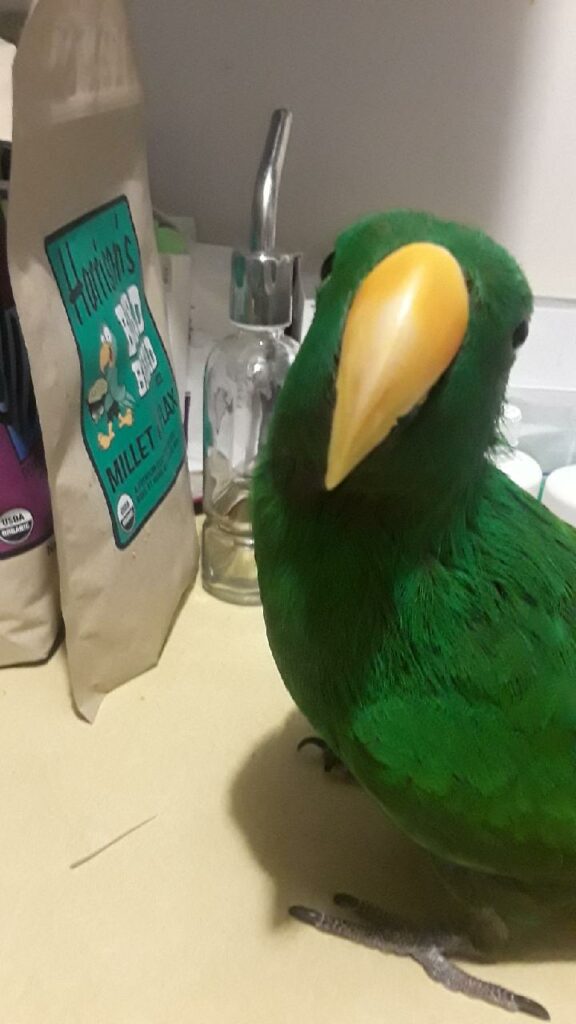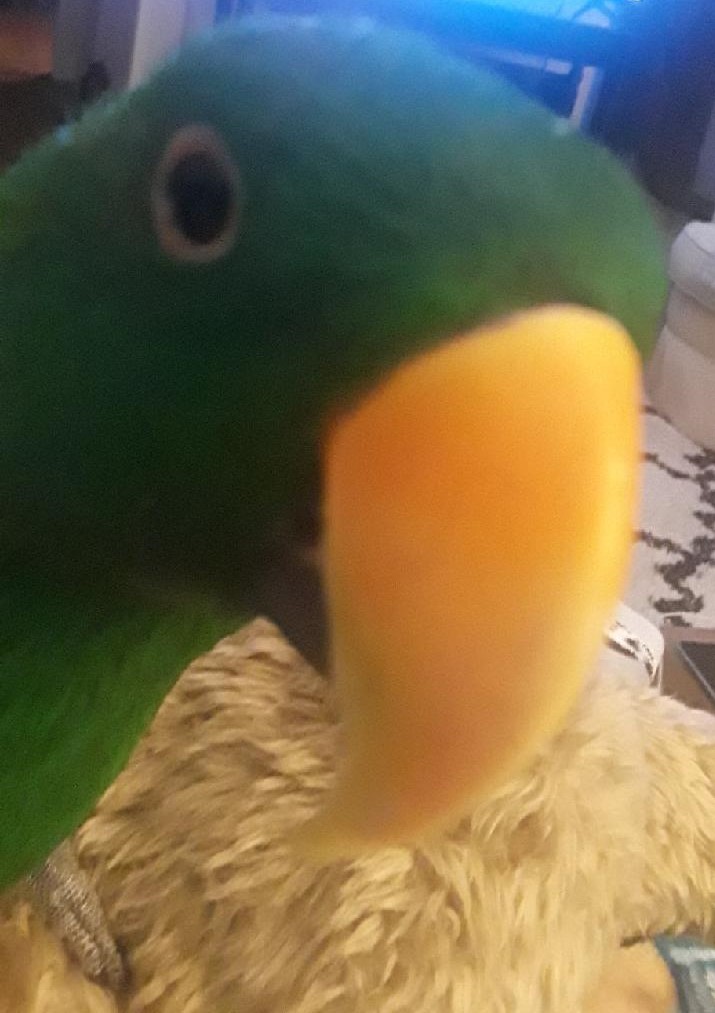Looking to adopt a pet bird? Already have a pet bird, but having some behavior problems? Don’t worry! There are a few changes at home that can alter most behavioral problems in birds. The most common problems include inappropriate sexual behavior, feather plucking, and aggression. Many of these are also a sign of health issues, so please see your veterinarian for a good health check up if you notice any of these in your bird.
Bird Behavior 101:
Birds in the wild spend a large portion of their time foraging (up to 80% of their waking hours). This keeps them busy all day! The remainder of this time is spent socializing, mating, and grooming. In captivity, however, they just have to climb over to their food bowls and eat their fill. This takes probably only 1-2% of their waking time. As a result, they have a lot of time to fill at home and they get bored quickly! When their foraging time is reduced, they must fill their time with their other natural behaviors.
Inappropriate sexual behaviors
Inappropriate sexual behaviors include regurgitation onto a human, masturbation, and egg laying. These are frustrating to us humans, and egg laying can take a huge toll on your bird’s body. These can all be a sign of reproductive issues, such as cancer, so please see a veterinarian if you start to notice new sexual behaviors. Your veterinarian will do a good physical examination and probably recommend x-rays and/or blood work. Once health issues are ruled out, we can start to treat this as a behavioral problem.
How to alter your behavior to alter your bird’s behavior
Humans unfortunately tend to encourage this behavior, because many of our normal behaviors actually are seen as sexual to birds. Touching a bird anywhere other than the top of the head or the bottom of the feet is seen as a sexual behavior; especially stroking the back. It is normal for us to want to pet our pets, but limit this to the top of the head only. We humans also like to share our food and table scraps with our pets (one of our natural behaviors is eating socially!). Sharing food with your bird, however, is also something only mated birds will do in the wild. When we share food or pet our birds’ backs and stomachs, we are essentially flirting with our birds– it would be really unfair to then expect your bird to NOT see you as a mate after receiving all those signals!
If your bird is regurgitating food or humping you, you must discourage this behavior. Put him in his cage when he does this. If he continues to see you as a mate, you may have to limit your interactions with him to only a few minutes per day until he calms down. Sometimes, handling birds too much is the culprit for these behaviors.
Environmental factors
Diet and light are also major contributing factors to these behaviors. Pet stores often sell seeds as a complete bird food– it is not! Seeds are very high in fat, low in calcium, and low in vitamin A. The high fat nature of seeds will make your bird’s body think it is spring time, the best time to have babies. We recommend a pelleted diet (e.g. Harrisons, Labefer, Mazuri) as a main staple, with lots of veggies and some fruits on the side. Pellets are lower in fat and have many more vitamins to make them a complete diet. Unfortunately, birds do not like pellets nearly as much as they do seeds, transitions can be tough! Please ask your veterinarian for help when transitioning your birds diet, as many birds refuse to eat it if you do not transition slowly enough.

Humans use a lot of light. We often have our lights on any time we are awake (15-18 hrs./day). This is a lot of light for your bird. Her pituitary gland may think that we are living in an eternal summer, and pump out a lot of hormones as a result. Covering your bird for at least 12 hours per day in a dark and quiet room (no TV, no nightlight, no family time) should help her break out of this cycle. She may need to have a bedtime cage (which can be much smaller than her regular cage) in a closet if you have a smaller space and cannot keep an entire room for her.
Medical assistance
If all else fails, there are ways to manage these behaviors medically. Unfortunately they all come with risks and side effects. Let’s talk Lupron. Lupron (luprolide acetate) is an inhibitor of GnRH (gonadotropin releasing hormone). This is the hormone that gets the follicles making eggs and the testes making sperm. Inhibiting this hormone, as a result, reduces the sexual behaviors of birds, as their hormones calm down. These injections typically last about 1 month, but every bird is unique. It does not work at all in some birds. The most common side effect is bruising/muscle damage at the injection site (painful!). The most serious side effect of this injection is bone marrow suppression, where all the red and white blood cells are made.
Suprelorin (deslorelin) implants are very similar to Lupron in that they also produce a GnRH inhibitor. These are tiny implants that your veterinarian will place under the skin under a light anesthesia. These typically last about 6 months, but every bird is different with this, too. In some it does not work at all, in some it lasts for a year or more. The infrequency of administration is the biggest benefit with Suprelorin, but it does carry the added risk of anesthetic death.
The last option is to have your bird spayed or neutered. Removing the testes/ovary will remove sexual hormones and reduce sexual behaviors significantly. Unfortunately, this is an extremely risky procedure, only done at specialty hospitals. The bird’s ovary sits right next to the aorta (the biggest blood vessel in the body), making the risk of bleeding very high. Birds also are prone to anesthetic complications with internal surgeries, such as hypothermia (getting too cold) and not breathing well. Surgery of this nature is only used as a very last resort, if the quality of life for the bird is in question.
Feather Plucking: Grooming behavior gone wrong
The dreaded feather plucking! This is one of the most common problems we see with birds. It can be secondary to infections, parasites, pain, and cancer, so you need a health check up from a vet before deciding it is behavioral. All birds groom! This is a completely normal bird behavior: the problem occurs when they do it too aggressively. Feather plucking is an abnormal grooming behavior. It often stems from boredom (remember the foraging thing?) or sexual frustration. If they cannot forage, if they cannot mate and interact with others, the only thing left to them is grooming. And so they do it to excess and end up pulling feathers out. Eventually, they can even damage skin, leading to secondary infections, bleeding, and pain.
Once this behavior starts, it can be hard to stop. The best way to manage this behavior is to encourage foraging for food. Remember, some grooming is NORMAL. Some birds end up needing to live their lives in a cone (there are some companies which make them in a soft, chewable form for birds. One example includes: https://birdsupplies.com/collections/feather-plucking-bird-collar. Putting these collars on can be stressful for your bird at first, so make sure to talk to your veterinarian before starting to use a collar. Your bird’s weight and behavior should be monitored closely during the first month of use, and birds can stop eating if the collar becomes too stressful.
Bird Behavior Problem 3: Aggression
Aggression is also a common complaint among bird owners. Whether the aggression is directed toward strangers, certain family members, or everyone, aggression can be a huge problem for the human-animal bond. The best way to manage aggression is good socialization, from many humans, at a young age. This is not always possible, obviously, as many birds are rehomed much later in life. Aggression can, in these cases, be managed, but not always completely ‘cured’. Aggression can stem from pain or perceived pain, so please ensure if your bird is biting and acting aggressive, to see a veterinarian. If your veterinarian determines your bird is healthy, and has no obvious causes for aggression, the training can begin!
Treats Galore!
The first step is to start counter conditioning. Find your bird’s favorite treat, and start to offer it after a clicker noise at least 10 times per day. Every time they hear the clicker, give a treat. After a few weeks, start to only feed the treat out of your hand. Do this either through the bars of the cage or, if you are comfortable, directly. After another few weeks, your bird should start to see you as a food giver, rather than an enemy. After this, start to train your bird to do various tricks (step up, hand shake, head bob, open wings, come, etc.). All of this takes a LOT of time and patience.
Sometimes, working with a trainer in your home can be very helpful. Although this can be difficult to find, there are many bird specialty stores which do offer some training basics. Remember throughout this process, your safety and your bird’s safety is the most important. If training is not going well, take a break and re-evaluate.

Adding a bird to your home requires patience, training, and a lot of dedication, but they make life-long friends.








